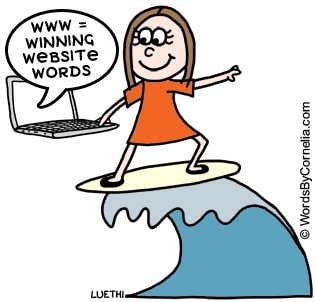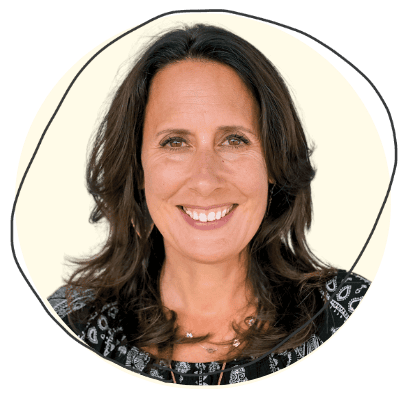“How long should a sales page be?” … That’s a very good question!
My answer: long enough to give your prospects all the information they need to make an informed purchasing decision.

But that’s such a vague answer…
Well, yes and no.
It might seem vague to you, but I’m about to share with you what should go on your sales page, so here’s a bit of a checklist for you…
What should be included on a sales page?
If you’re wondering what to include on a sales page, you need to put yourself into your prospects’ shoes and consider their needs and concerns.
So you’d start off with:
1. An attention-grabbing headline: this must address the prospects’ primary problem or concern
If you’re not sure what the primary problem is that your prospects face, you need to ask them. Or your sales message risks falling flat.
Once you’ve got a really good headline:
2. Demonstrate that you understand your prospects’ primary problem
Show a bit of empathy… and dig a little bit deeper into the pain. The prospect then realises that you ‘get’ them… and that you may just have the answer they’re looking for.
3. Present your solution
This is where you talk about the features and benefits of your product or service.
4. Testimonials
Yes, testimonials really work. (Though there are interviewing techniques that will help you get a good, believable testimonial that’s more credible than the average sickly-sweet testimonial.) Photographs of the testimonial people add extra credibility to your message.
It’s a good idea to sprinkle a number of testimonials throughout the sales page. Testimonials should be carefully selected to cover key objections your prospects may have.
5. Bullet points
Cover every single benefit of your product or service with bullet points.
Yes, really – people can buy your product or service based on one single, tiny, feature.
What’s more, by listing all the benefits it shows that your product or service has depth. Readers will begin to imagine themselves benefitting from what’s there – and they can do that because your message is so specific.
Here’s an example to show why detailed bullet points work best:
This example is from my own sales page, for my eBook the ‘Website Owner’s Manual’.
Imagine that you’re a small business owner, and you’ve got a website that isn’t converting.
Which of the following is more enticing sales copy:
(a) Tips on how to get your website converting better;
or:
(b)

… There’s a good chance that one of these specific bullet points will hit a nerve, and compel a prospect to buy.
A vague bullet point won’t do that.
What’s more, notice how I’ve added page numbers next to each bullet point. This does a number of things:
- It creates the “I want that factor”. If you’re struggling with one of those topics, having the solution waved in front of you creates desire.
- It creates credibility. My promises aren’t vague; they’re real.
- Once a customer has bought from you, they can access the information really quickly if they need to.
So yeah, detailed bullet points are your friend. 🙂
6. Screenshots and graphics
Adding graphics and screenshots of what’s inside your product is a good idea. (Not just the packaging shots, but nitty-gritty detail shots.)
Not only do graphics perk up your sales page (to balance out all the words), but it’s another way of boosting credibility, too.
7. Risk reversal and the buying process
It’s a good idea to outline what happens next in the buying process, so that the customer doesn’t hit any potholes they’re not expecting. (If they know what’s likely to happen during the checkout process, they’re less likely to abandon it.)
A guarantee of some sort is really powerful here too. If you’re an internet marketer, a money-back guarantee is the norm.
If you’re in the professional services industry, that may not be such a relevant guarantee, so you’ll need to come up with another risk reversal mechanism. This could be a Promise, or a Pledge, for example.
8. Bonuses
If you’re offering bonuses, explain why they’re fabulous and such must-have items!
9. Product offer
Yep, this is where you name your price.
You may want to remind readers of your Guarantee (or other risk-reversal mechanism) at this point.
10. Customer service information
Technology isn’t perfect, so someone’s bound to encounter problems buying online. So be sure to include key contact details (which is great for trust-building, and therefore conversions, too).
11. Personal sign-off
Add your signature and profile photograph at the end of the sales page… this personal touch provides credibility and helps with conversions.
(No-one likes buying from ‘anonymous’ websites… it’s like the business owner has something to hide, and will raise a red flag to many of your prospects.)
12. “PS” message
Repeat your main message as a “PS” at the bottom. It’s surprising how many people will skim-read (or scroll through) the bulk of the sales copy, but will read the PS. So make it good – and make it stand out.
Can any other copywriters verify this approach to long sales copy?
Yes… and I’ll refer to two copywriters and internet marketers whose work I respect.
First of all, Sean D’Souza at Psychotactics.com has tested long versus short sales copy over many years. He’s discovered that long sales copy (when it’s well written and constructed) can increase sales – and result in fewer refund requests.
I really respect Sean’s work, as he walks the walk when it comes to marketing. He is very open about what’s been successful for him. (And if you haven’t read his book The Brain Audit, you should, it provides a good insight into why customers buy – and why they don’t. Plus you’ll see his own sales page when you click on the link.)
What’s more, Sean’s copywriting approach his classy. Personally I’m not big on sales pages that use lots of highlighter pens and pop-ups and look like get-rich-quick schemes… ugh! So I’m happy learning from Sean’s approach (I’ve taken a number of his courses) because (a) his techniques work, and (b) it’s a classy, high-quality approach.
Secondly, copywriter Bob Bly is an interesting character to watch. He reportedly makes a massive income from selling eBooks online (as well as from his freelance copywriting), so he’s got some interesting techniques to observe. All of his sales pages are long… the structure may be a little bit different to what I’ve outlined above, but most of the elements are covered. Here’s a example of a Bob Bly sales page, for his product on Building A Large and Profitable Email List.
You’ll notice that Bob Bly has “Order Now” buttons scattered throughout the page, whereas Sean D’Souza has the “Buy Now” buttons at the very end… this is because Sean wants you to read his sales copy right to the very end. (Fewer refunds that way!)
In short: successful internet marketers and copywriters whom I respect use long sales pages, so that’s the approach I’d recommend.
But I hate long sales copy…
If you hate long sales copy, you need to remember that the sales page isn’t for you – it’s for your prospects.
Besides, doesn’t the idea of more sales and fewer refunds appeal to you? C’mon!
But I really REALLY hate long sales pages…
OK, if you really REALLY hate long sales pages there is one more approach. But I’m writing about it with a Disclaimer, because I haven’t tested for myself how successful this approach is or not.
Here’s what you do:
1. Create a really enticing (short) sales page
This includes two links: a Buy Now link, and a link to More Information.
This makes the page appealing to both Decisive Dan and Tentatitve Tom readers.
2. The More Information page gives all the product details
… So essentially, you still have to write long sales copy… it’s just that not everyone is forced to read it.
Here are the problems I foresee with this approach:
- (a) You have two website pages to maintain instead of one.
- (b) You have an additional metric to measure, i.e. how many people are clicking through to the second page.
- (c) You’ll most likely have more refund requests, because some people haven’t bothered to find out what they’re buying.
It’s your choice, but I think it may just be easier to have one long page…! 😉
Summary
- How long should a sales page be? Long enough to give your prospects the information they need to make an informed decision.
- A good sales page should include the following:
- 1. An attention-grabbing headline: this must address the prospects’ primary problem or concern
- 2. Demonstrate that you understand your prospects’ primary problem
- 3. Present your solution
- 4. Testimonials
- 5. Bullet points
- 6. Screenshots and graphic
- 7. Risk reversal and the buying process
- 8. Bonuses
- 9. Product offer
- 10. Customer service information
- 11. Personal sign-off
- 12. “PS” message
- Successful internet marketers and copywriters whom I respect use long sales pages because these pages increase sales and decrease refund requests.



